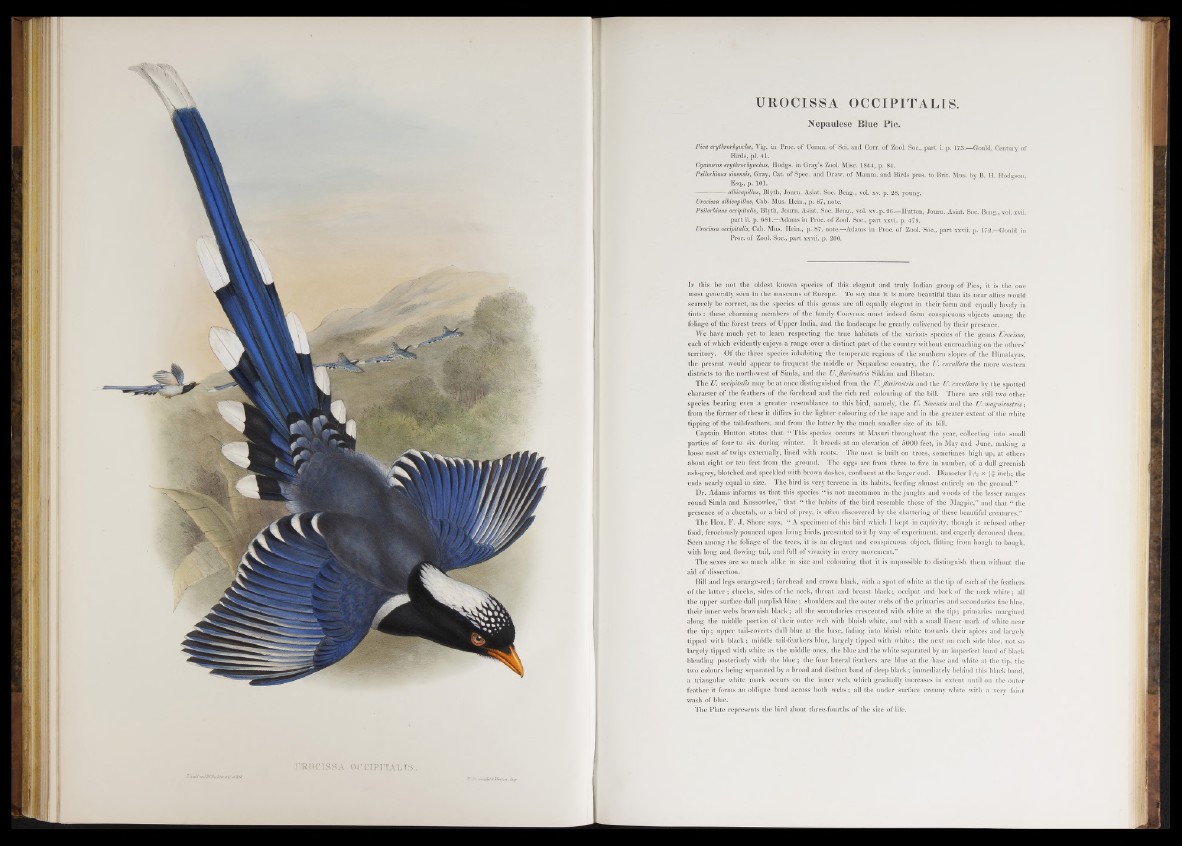
Nepaulese Blue Pie.
Pica m/throrhyncha, Vig. in Proc. of Comm, o f Sei. and Corr. of Zool. Soc., p a r t i. p. 173.—Gould, Century of
Birds, pi. 41,
Cyanurus erythrorhynchus, Hodgs. in Gray’s Zool. Misc. 1844, p. 84.
Psilorhinus sinensis, Gray, Cat. of Spec, and Draw, of Mamm. and Birds pres, to Brit. Mus. by B. H. Hodgson,
Esq., p. 101.
----------------albicapillus, Blyth, Journ. Asiat. Soc. Beng., vol. xv. p. 28, young.
Urocissa albicapillus, Cab. Mus. Hein., p. 87, note.
Psilorhinus occipitalis, Blyth, Journ. Asiat. Soc. Beng., vol. xv. p. 26.—Hutton, Joum. Asiat. Soc. Ben°\, vol. xvii.
p a r t ii. p. 681.—Adams in Proc. o f Zool. Soc., p a rt xxvi. p. 479.
Urocissa occipitalis, Cab. Mus. Hein., p. 87, n o te—Adams in Proc. o f Zool/Soc., p a r t xxvii. p. 172.—Gould in
Proc. of Zool. Soç., p a rt xxvii. p . .200.
I f this be not the oldest known species of this elegant and truly Indian group o f Pies, it is the one
most generally seen in the museums of Europe. To say that it is more beautiful than its near allies would
scarcely be correct, as the species o f this genus are all equally elegant in their form and equally lovely in
tin ts : these charming members of the family C orv id® must indeed form conspicuous objects among the
foliage of the forest trees of Upper India, and the landscape be greatly enlivened by their presence.
We have much yet to learn respecting the true habitats of the various species of the genus Urocissa,
each of which evidently enjoys a range over a distinct p art of the country without encroaching on the others’
territory. Of the three species inhabiting the temperate regions of the southern slopes o f the Himalayas,
the present would appear to frequent the middle or Nepaulese country, the U. cucullata the more western
districts to the north-west of Simla, and the V flavirostns Sikkim and Bhotan.
The U. occipitalis may he at once distinguished from the U. flaoirostris and the V cucullata by the spotted
character of the feathers of the forehead and the rich red colouring o f the bill. There are still two other
species bearing even a greater resemblance to this bird, namely, the U Sinensis and the U magnirostris;
from the former of these it differs in the lighter colouring of the nape and in the greater extent of the white
tipping of the tail-feathers, and from the latter by the much smaller size o f its bill.
Captain Hutton states th at “ This species occurs at Masuri throughout the year, collecting into small
parties of four to six during winter. It breeds at an elevation of 5000 feet, in May and June, making a
loose nest o f twigs externally, lined with roots. The nest is built on trees, sometimes high up, at others
about eight or ten feet from the ground. The eggs are from three to five in number, of a dull greenish
ash-grey, blotched and speckled with brown dashes, confluent at the larger end. Diameter 1-jV x 44 inch: the
ends nearly equal in size. The bird is very terrene in its habits, feeding almost entirely on the ground.”
Dr. Adams informs us that this species “ is not uncommon in the jungles and woods of the lesser ranges
round Simla and Kussowlee,” that “ the habits of the bird resemble those of the Magpie,” and that “ the
presence of a cheetah, or a bird of prey, is often discovered by the chattering of these beautiful creatures.”
The Hon. F. J . Shore says, “ A specimen of this bird which I kept in captivity, though it refused other
food, ferociously pounced upon living birds, presented to it by way of experiment, and eagerly devoured them.
Seen among the foliage of the trees, it is an elegant and conspicuous object, flitting from bough to bough,
with long and flowing tail, and full o f vivacity in every movement.”
The sexes are so much alike in size and colouring that it is impossible to distinguish them without the
aid of dissection.
Bill and legs orange-red; forehead and crown black, with a spot of white a t the tip of each of the feathers
of the latter ; cheeks, sides of the neck, throat and breast black; occiput and hack of the neck white; all
the upper surface dull purplish b lue; shoulders and the outer webs o f the primaries and secondaries fine blue,
their inner webs brownish black; all the secondaries crescented with white at the tip ; primaries margined
along the middle portion of their outer web with bluish white, and with a small linear mark of white near
the t ip ; upper tail-coverts dull blue at the base, fading into bluish white towards their apices and largely
tipped with black; middle tail-feathers blue, largely tipped with white; the next on each side blue, not so
largely tipped with white as the middle ones, the blue and the white separated by an imperfect band of black
blending posteriorly with the blue ; the four lateral feathers are blue at the base and white at the tip, the
two colours being separated by a broad and distinct band of deep b lack; immediately behind this black band,
a triangular white mark occurs on the inner web, which gradually increases in extent until on the outer
feather it forms an oblique band across both webs; all the under surface creamy white with a very faint
wash of blue.
The Plate represents the bird about three-fourths of the size of life.